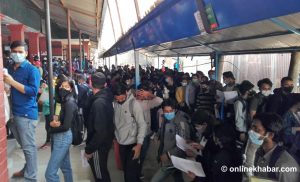The never-to-expect crisis is back again bringing chaos in the educational sector among others, and we never know how long this situation will continue in the future. It puts a lot of pressure on educational institutions and other educational stakeholders to plan once again to manage education during this difficult circumstance. Physical teaching and learning are halted at this time. But, the silver lining is that Nepal already has some policy documents at the national level such as the Student Learning Facilitation Guidelines, 2020, and the Framework for School Operation, 2020, to facilitate education in general, and equally there are some local institutional guidelines as well to guide teaching and learning during the crisis. On top of that, our recent past practices of handling education during the crisis have taught us amply.
Adding to them, following are some of the ideas drawn on the basis of the observation of those practices for application to Nepal’s education sector.
Plan and act, don’t wait and see
All educational institutions should plan to manage education by mapping out their available resources. Therefore, this time, they should not wait for the situation to improve.
Running online classes is one of the options. However, it is not only the option available. Hence, as per the availability of resources with institutions, teachers and parents, the institutions have to plan to manage education in multiple ways as far as possible instead of merely jumping to a conclusion to adopt the approach of online teaching and learning. They should consider the availability of necessary digital resources with teachers, students and parents and their required basic digital literacy to engage learners in online learning.
Simply put, there should always be an alternative plan such as homeschooling that have to be communicated well in advance to digitally disadvantaged parents and students to bring them into the education system during the crisis.
Circulate proper guidelines
Proper guidelines on how to get learners engaged in online classes or on any other ways adopted to continue teaching and learning should be circulated to teachers, parents and students. In addition, what parents and students are expected to do should be communicated well to them before any approach is adopted. Both the parents and students should also be clarified of any additional support if they are unable to join online classes.
If an institution plans to run online classes, it needs to understand that using synchronous tools such as Zoom, MS Teams, EZ Talks, Google Meet for junior classes can be just a waste of time as children are too young to learn via synchronous communication. Instead, they can be involved in learning using asynchronous platforms such as Google Classroom, Edmodo or any other locally developed platforms that the institutions are using to manage education.

We have realised that continuous lecture in online teaching is so tedious and rather it demotivates the learners. Therefore, a teacher has to have some plans to make the lessons interactive. For instance, assigning them a pre-live session task or sending them a video to watch beforehand and making them take part in a discussion in live sessions may result into an interactive live session.
Since a large number of teachers got engaged in online teaching and learning during the first phase of the crisis, they have some knowledge of handling some web tools. Hence, at this point, we need to think about how we can effectively engage learners in teaching and learning as opposed to simply running online classes to transition to online teaching and learning. In case the institutions are preparing to conduct exams during this difficult situation, they have to make sure that learners and/or parents are familiar with the digital tools that they are using so that their academic performance should not be impacted because of their poor digital literacy.
Address the issue of mental wellbeing
Institutions have to clearly articulate the concerns of mental wellbeing in messages they circulate to teachers, parents and students. Learners might be worried as they might not have appropriate devices to join online learning, or the environment at home might not be conducive for students to learn etc.
Institutions have to clearly mention that it is only the ’emergency remote teaching’ as a professor of instructional technology, Charles Hodges, and his colleagues claim, and the learners should not be worried about what they potentially miss at this stage because once the situation gets normal, there is always a possibility to recover what they miss now. Institutions can also ask if the parents and learners have any issues which an institution can address. Teachers should also be assured that their institution is always with them to support when needed, and the teachers can contact their institution if they face any kind of difficulties in course of teaching and learning during the crisis. They should be given additional support such as providing appropriate digital devices that can help them get engaged in teaching and learning.
To sum up, there are some ways to manage education during this crisis that are informed by our past practices. We can be better organised this time to deal with education if we carefully consider some key elements such as planning properly, developing guidelines to manage education and making attempts to address mental wellbeing issues of teachers, learners and parents. Finally, we all have experiences of living through the crisis; therefore, managing education during this recurring crisis situation will not be something unusual, rather it will make us extra prepared to manage education during any kind of crisis situations that we might acquaint ourselves with in the future.























